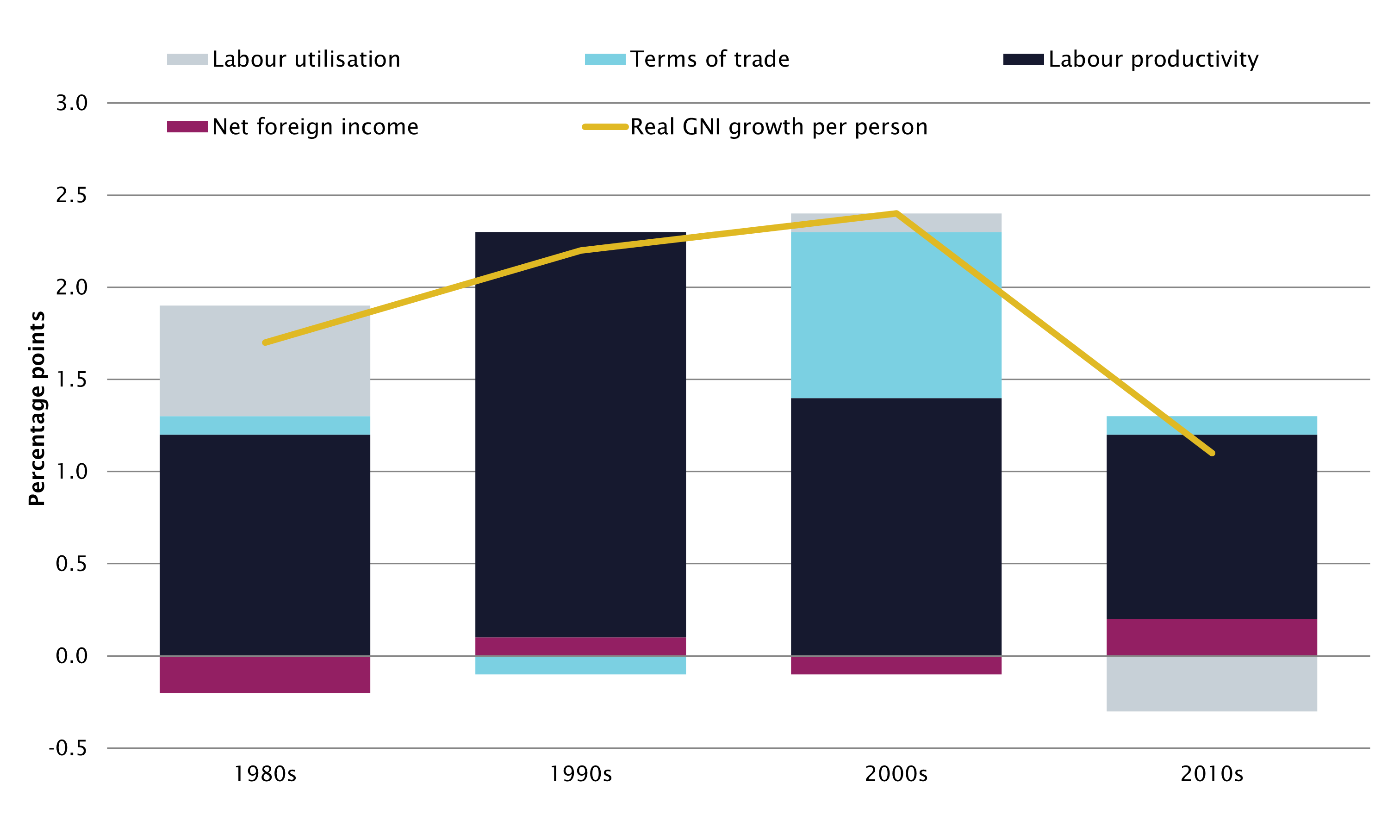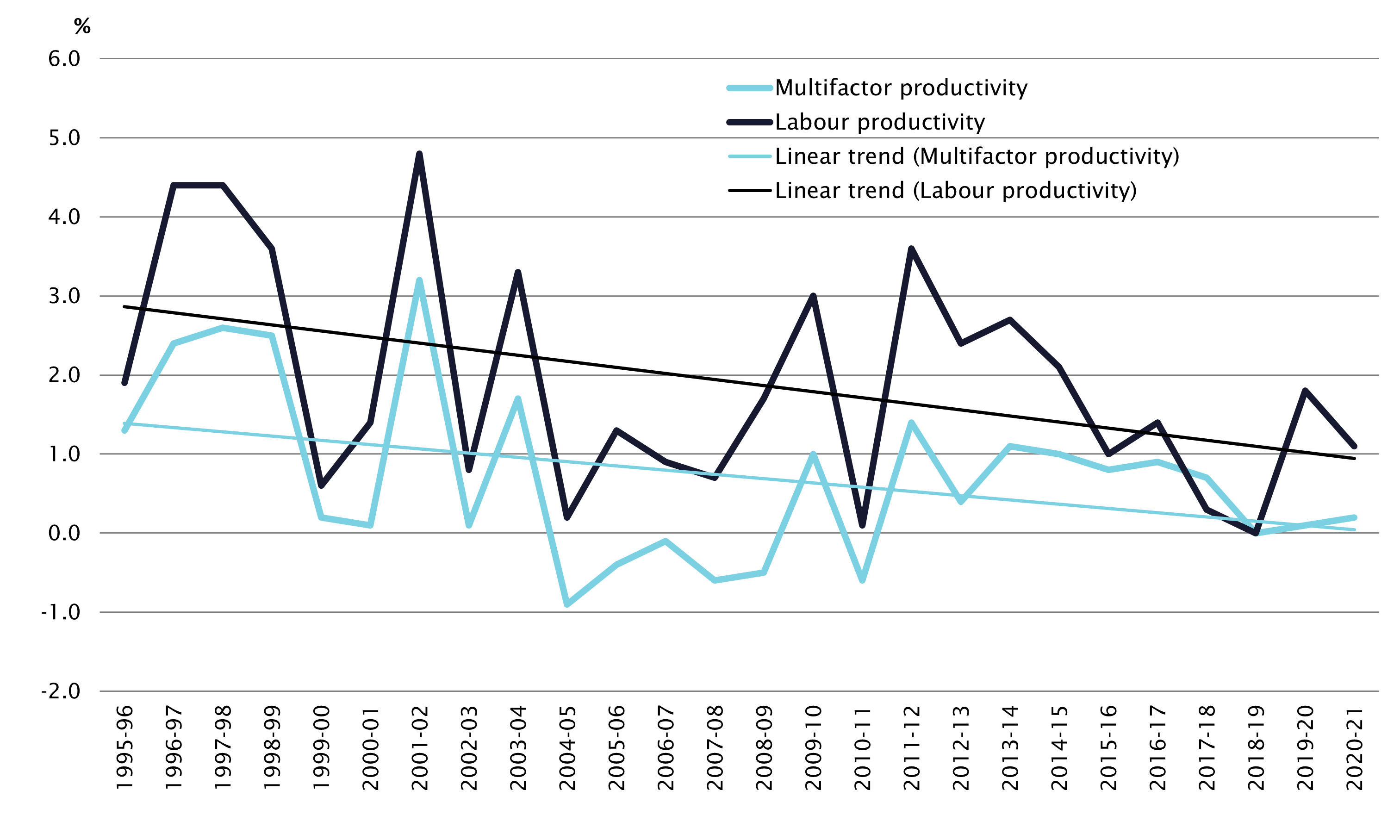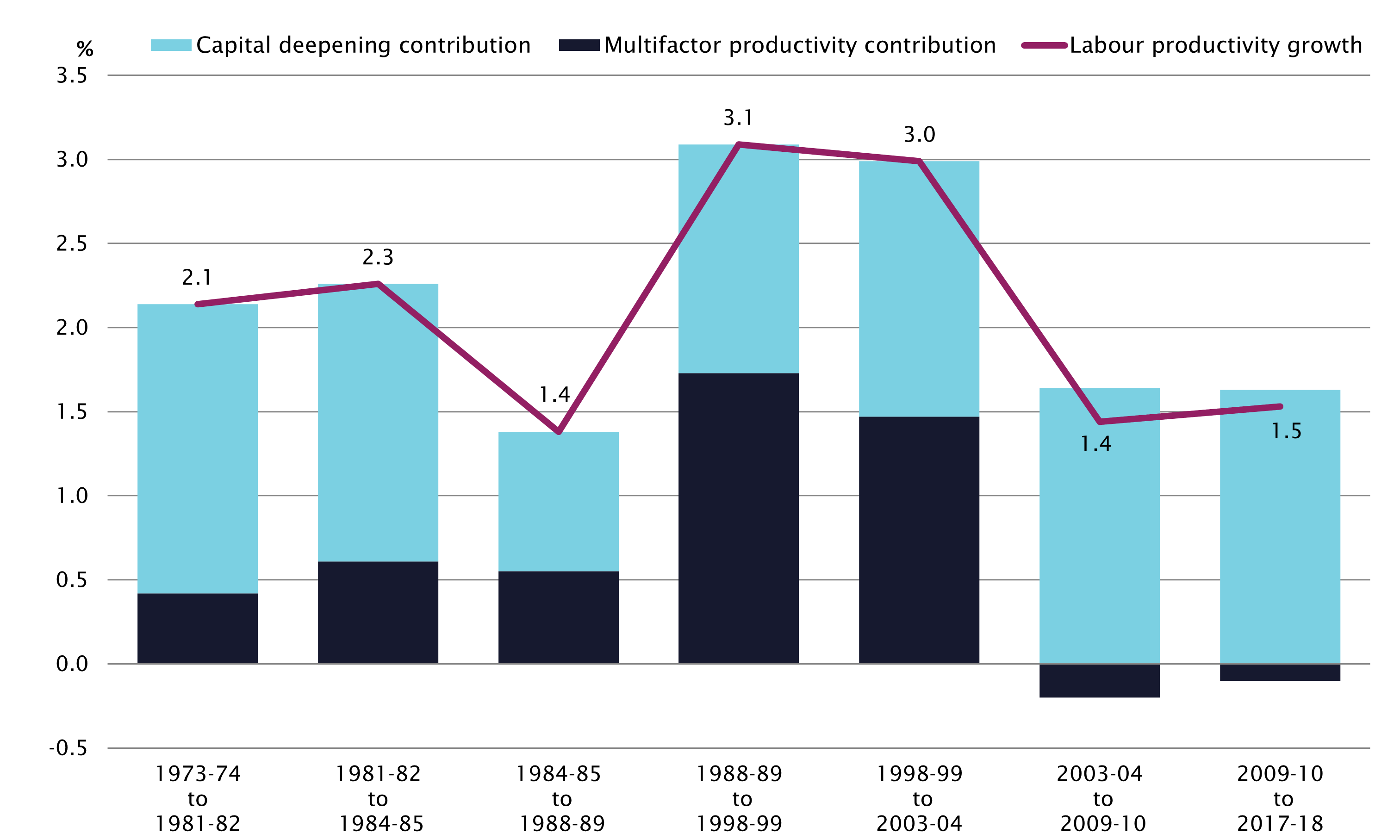Rodney Bogaards, Economic Policy
Key issue
Productivity growth is a key contributor to increases in economic welfare. In Australia productivity growth has been low for decades.
A key reason for the productivity slowdown is a decline in business dynamism (as evidenced by a decline in firm entry and exit rates), which has slowed the rate of innovation and technology adoption by firms and slowed the reallocation of resources to the most productive firms.
Government policies to address barriers to business dynamism and increase competitive pressures to incentivise firms to innovate and improve performance could improve Australia’s productivity growth.
Productivity growth is crucial to improved living
standards
According to Treasury’s 2021 Intergenerational
report (IGR), labour productivity (LP) has contributed more than 80% of
the growth in Australia’s living standards, measured by real gross national
income (GNI) per person, over the last 30 years (see Figure 1).
The IGR outlines that GNI measures how much
Australia earns, rather than what output is produced in the economy. It
measures total income received in Australia from residents and businesses located
in Australia and abroad. Real GNI per person is often used as a measure of a country’s
standard of living because it captures a country’s average real income per
person from the economic activity of its residents and businesses regardless of
where they are located.
For economic living standards to improve there must
be sustained LP growth. LP is defined as the ratio of output to labour input.
For example, the amount of output produced for an hour of work. An increase in
LP means that more output is being produced per hour of work.
As shown in Figure 1, LP has been the most crucial
factor, but not the only factor, in improving living standards in past decades.
For example, during the 2000s when LP growth fell, growth in real GNI per
person was maintained because of a significant ‘terms
of trade boom’. This made up for the decline in LP growth during that
period.
The terms of trade have a direct impact on real
incomes. The terms of trade measure export prices relative to import prices. During
the 2000s, Australia experienced a terms of trade boom because export prices for
commodities (such as iron ore, coal and natural gas) were high relative to
import prices. The boom was driven by demand for Australia’s commodities from
China. The higher terms of trade meant that Australians could buy more imports
for a given quantity of exports- thereby improving their real incomes. However,
it is unlikely that Australia can rely on the terms of trade to sustain strong
living standard improvement in the coming decades because of its highly
cyclical nature.
Figure 1 Contributions to real GNI per person growth (measured
in percentage points)

Source: Treasury, 2021 Intergenerational Report, (Canberra,
Treasury, June 2021), 46.
LP growth is not straightforward, and is calculated
as the sum of multifactor productivity (MFP) and capital deepening:
- MFP is the ratio of output to a combined input of labour and
capital. It captures improvements in the quality of inputs and/or how they are
combined and is often treated as an indicator of technological change
- Capital deepening refers to changes in the capital to labour ratio.
For example, using technology to automate production, and saving on labour, will
result in increased capital deepening.
The box below discusses these concepts in more
detail.
Measuring productivity
Labour productivity (LP) measures the output produced per unit of labour input (usually hours worked).
LP growth captures improvements in the efficiency of labour, due to capital-deepening (growth in the ratio of capital to labour) and improvements in the efficiency with which capital and labour are combined, referred to as multifactor productivity (MFP).
MFP measures the output produced per unit of combined inputs of labour and capital.
MFP growth reflects changes in output occurring for reasons other than increases in the quantity of capital and labour. In essence, it captures improvements in the quality of inputs and/or how they are combined, and is often treated as an indicator of technological change.
An improvement in labour quality might include a more educated or skilled worker. An improvement in capital quality might include a new machine that has doubled its throughput.
Figure 2 shows the annual
movement of market sector LP and MFP since 1995–96. Labour productivity grew
1.1% and MFP rose 0.2% in 2020–21.
Figure 2 Market
sector, productivity growth – hours worked basis (annual percentage change)

Source: Australian Bureau of Statistics (ABS), Estimates of Industry Multifactor
Productivity, 2020–21, (Canberra: ABS, December 2021).
Ideally, productivity
measures should cover all economic activities. However, this is only possible
if all the necessary data is available. The market sector comprises 16 of the
19 industries under the Australian and New Zealand Industrial Classification. Until
2009–10, the market sector consisted of 12 industries. The wider coverage of
the current market sector definition improves its relevance because it reflects
the growing contribution of service industries in the economy.
The market sector excludes
Public Administration and Safety, Education and Training and Health Care and
Social Assistance because these are service industries in which most of the
output is provided free of charge or at non-market prices. Output measures for
these service industries are typically derived using input costs and therefore
there is no productivity growth. Together these non-market industries account
for 17.8% of GDP. Ownership of dwellings is also excluded from the market
sector because no employment is associated with it (accounting for 8.5% of GDP).
This means more than a quarter of economic output is excluded from the
productivity equation.
Productivity growth in
Australia has slowed in recent decades
Changes in productivity growth are best observed
over longer productivity growth cycles rather than through annual movements.
This is because productivity cycles minimise the effects of cyclical factors
that can cause large year-to-year productivity changes. For example, in
downturns, firms tend to retain labour because they do not want to dismiss
workers who have valuable skills that they will need in the future. This means
labour (and capital) may only be partially utilised, reducing annual
productivity.
Using productivity cycles,
Figure 3 shows Australia’s aggregate LP growth (real output per hour) has
dropped to around 1.4% to 1.5% over the last 20 years after achieving
around 3.0% from the late 1980s through to the early 2000s.
Figure 3 Decomposition of labour
productivity by productivity cycle (average growth per cycle)

Source:
ABS, Estimates of Industry Multifactor Productivity, 2020–21, (Canberra: ABS, December 2021).
The superior productivity performance
from the late 1980s through to the early 2000s has been widely attributed to
the micro-economic and macro-economic reforms implemented by successive
governments, including the National
Competition Policy (NCP), which
created more competitive and flexible markets by:
- reforming regulations that unjustifiably
restricted competition
- reforming the structure of public
monopolies
- providing third-party access to nationally
significant infrastructure
- restraining monopoly pricing behaviour
- fostering competitive neutrality between
government and private businesses
- limiting anti-competitive conduct of firms.
These NCP reforms
encouraged businesses to become more efficient and innovative, encouraging them
to adopt new and improved technologies, particularly in information and
communications technology. Other micro-economic and macro-economic reforms that
occurred during the 1980s and 1990s are discussed in Australia’s productivity challenge (from the Briefing book for the 46th Parliament),
and are also discussed in the Treasury Working Paper, Australia’s
experience with economic reform.
By far the largest
contributor to the decline in LP growth has been the decline in MFP growth. In the
2 most recent complete productivity cycles (2003–04 to 2009–10 and 2009–10 to
2017–18) MFP growth has been negative. This means the efficiency with which
labour and capital inputs are being used together in producing output has been
going backwards.
According to the IGR, a
slowdown in productivity growth is not unique to Australia. Other developed
economies (such as the US, Canada, the UK, and New
Zealand) are facing similar situations, with Australia’s productivity slowdown
largely consistent with that experienced in most other developed economies.
What are the key factors
behind the recent slowdown?
According to the IGR, the
productivity slowdown in Australia may reflect a ‘mix of factors’, including:
- declining business dynamism, reflected in a decline in firm entry
and exit rates, which has caused a slowing in firms’ rate of innovation and
adoption of modern technologies, and a slowing of resource allocation from less
productive to more productive firms. This lack of ‘creative destruction’ is consistent
with a recent Bank
for International Settlements (BIS) study that suggested the share of
zombie’ firms in Australia has been increasing. Zombie firms are defined by the
BIS as firms that are unprofitable but remain in the market, in recent times
with government support, rather than exiting through takeover or bankruptcy. The International
Monetary Fund (IMF) also suggests a decline in business dynamism has been
brought about by reduced competition, as evidenced by increased market
concentration and increased markups (of price over marginal cost) in Australia
- structural changes in the economy as more
activity shifts to the services sector, particularly in sectors that cater to
an older population that tends to be less capital intensive, has slower
productivity growth, or cannot be measured using traditional productivity
metrics
- difficulties in capturing recent
technological advances such as artificial intelligence and digital platforms in
measured productivity and a potential lag between these types of technological
progress and productivity growth that means productivity gains are taking
longer to be realised
- ‘slower growth in educational attainment
and labour quality’ (p. 50), as a substantial portion of the workforce is already
highly educated.
The IGR also
indicated that it was unclear whether the lasting effects of the COVID-19
pandemic on productivity growth will be positive or negative. On the one hand,
a shift towards working-from-home and online business models could lead to
enhanced innovation and productivity outcomes in some industries. On the other
hand, the COVID-19 pandemic could also worsen pre-existing challenges for
productivity growth (for example, declining economic dynamism, through growing
market concentration, reduced levels of firm entry and exit, and less job
switching).
The productivity outlook
The IGR baseline projections assume that underlying
productivity growth converges, over the next 10 years, to 1.5% per year –
consistent with the average annual growth rate in labour productivity over the past
30 years to 2018–19. On the other hand, independent consulting firm, Oxford
Economics, projects the average LP growth rate in Australia will be around 0.8%
per annum between 2021 and 2030 (median 0.8%).
In recognition of the uncertainties of the effects
of COVID-19 on productivity growth, the IGR considered an alternative scenario of
1.2% per year for productivity growth. That is, under this scenario, growth in
underlying productivity is assumed to converge to 1.2% by 2024–25 and remain at
that rate of growth for the remaining period. This results in the projected
level of real and nominal GDP to be around 9.5% lower by the end of the IGR projection
period (that is, 2060–61), due to lower average annual real GDP growth (see
Figure 4).
Figure 4 Impact of lower productivity
growth on real GDP growth (annual percentage change)

Source: Treasury, 2021
Intergenerational Report, (Canberra: Treasury, June 2021), 53.
Productivity growth of 1.2% per year is projected
to reduce relative living standards. GNI per person under the lower growth
scenario is projected to be $32,000 lower by the end of the projection period
compared with the baseline.
Compared with recent experience, a 1.5% trend
productivity growth rate is less likely than the lower 1.2%-per-year scenario,
at least without additional policy drivers aimed at improving productivity.
What can governments do to boost productivity
growth and raise living standards?
Continuing low productivity growth is clearly
possible but this would come at a cost to the Australian community. As the Parliamentary
Budget Officer stated in a Parliamentary Library seminar on fiscal
sustainability:
Recent reforms to return to higher
productivity growth have been patchy … A sustained decline in productivity
growth would represent a failure on many levels. It would also mean a
long-lasting stagnation in the living standards of all Australians. It would
also be significant on a narrower, budgetary level [lower productivity growth
would result in lower GDP growth, and therefore a higher debt-to-GDP ratio for
longer].
Governments can play a vital role in boosting
productivity growth by establishing policy and regulatory settings that
facilitate efficient business investment, enhance product market competition,
and improve the health and capability of the workforce.
The IMF has
recently suggested a strong structural reform push is essential for reigniting
Australia’s productivity growth. It proposed that the Australian Government
should implement the following suite of policies:
- promote productivity-enhancing investments in research and
development and information and communication technologies
- enhance competition through further product market deregulation
- alleviate financing constraints on small and medium enterprises
- promote venture capital
- expand the recognition of occupational licenses across more
occupations and across all states and territories
- improve teacher training and student outcomes through reforms in
the education sector
- increase training and job search assistance to help the long-term
unemployed transition to new jobs.
A recent Treasury working paper has argued that policies to address barriers to business dynamism and
competitive pressures can improve Australia’s productivity performance. In
addition, policies that facilitate more widespread adoption of emerging digital
technologies can also help boost productivity performance.
As one of the authors of the Treasury working paper
commented to the Australian newspaper:
… we need to update competition policy for the
digital age, reduce entry barriers for new businesses, stop supporting ‘zombie’
and lagging firms with taxpayers’ funds, and remove mobility-sapping
distortions related to occupational licensing and housing taxation.
Martin
Parkinson, the former secretary of the Department of the Prime Minister and Cabinet and Treasury,
agrees that the most important structural reforms that Australia can undertake
are those that encourage innovation and entrepreneurship:
Part of the problem is that reform has been
reduced to changing the tax system and industrial relations,” he says. “The
real reform areas are around fostering innovation and entrepreneurship and
finding ways to grow world-competitive businesses.”
“We also need to think about how we digitise
the economy, give people incentives to invest and take sensible risks, how to
rid ourselves of unnecessary regulatory burdens, some of which have arisen due
to the heightened focus on national security, but all of which can throw grit
into the mill and undermine our economic prospects.
However, Mr Parkinson goes on
to say that undertaking structural reform may be easier said than done if
government and alternative parties do not support the need for reform.
The 47th Parliament will benefit from a source
of ideas for potential policy improvements delivered by the
Productivity Commission. In February 2022, the Morrison Government tasked the Productivity Commission with undertaking its second
5-yearly review of Australia’s productivity performance.
The Productivity
Commission’s first 5-yearly review Shifting the dial was published in August 2017 and put forward
several recommendations for how governments can positively influence
productivity, including:
- making Australia’s health system more oriented to achieving outcomes,
rather than paying for services
- creating a good-quality and adaptive education and training system
and ensuring a well‑functioning labour market
- improving the functioning of towns and cities by improvements to public
infrastructure, road funding and investment, planning and land use policies and
access to housing
- improving the efficiency of markets by improving competition and
reducing unnecessary regulatory burden
- making governments work more effectively through better
intergovernmental relations and management of public finances and developing
stronger policy development and delivery capabilities.
The terms of reference for the 2022 Productivity Commission review state:
The Commission is to
review Australia’s productivity performance and recommend an actionable roadmap
to assist governments to make productivity-enhancing reforms. Each recommendation
should qualitatively and quantitatively estimate the benefit of making the
reform and identify an owner for the action and a timeframe in which it might
occur.
Alan Kohler recently conjectured in the New Daily newspaper, the ‘[new] Productivity
Commission blueprint might focus the collective political mind and provide some
cover for tough decisions’.
Further reading
Treasury, 2021 Intergenerational Report: Australia Over the Next 40 Years, (Canberra: Treasury, June 2021).
International Monetary Fund (IMF), Australia: Selected Issues, IMF Country Report no. 21/256, (Washington DC: IMF, December 2021).
Dan Andrews et al, Reaching for the Stars: Australian Firms and the Global Productivity Frontier, Treasury working paper, (Canberra: Treasury, January 2022).
PC productivity insights, Producitivy Commission
Back to Parliamentary Library Briefing Book
For copyright reasons some linked items are only available to members of Parliament.
© Commonwealth of Australia

Creative Commons
With the exception of the Commonwealth Coat of Arms, and to the extent that copyright subsists in a third party, this publication, its logo and front page design are licensed under a Creative Commons Attribution-NonCommercial-NoDerivs 3.0 Australia licence.